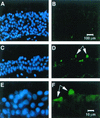Human coronavirus 229E infects polarized airway epithelia from the apical surface
- PMID: 10982370
- PMCID: PMC102122
- DOI: 10.1128/jvi.74.19.9234-9239.2000
Human coronavirus 229E infects polarized airway epithelia from the apical surface
Abstract
Gene transfer to differentiated airway epithelia with existing viral vectors is very inefficient when they are applied to the apical surface. This largely reflects the polarized distribution of receptors on the basolateral surface. To identify new receptor-ligand interactions that might be used to redirect vectors to the apical surface, we investigated the process of infection of airway epithelial cells by human coronavirus 229E (HCoV-229E), a common cause of respiratory tract infections. Using immunohistochemistry, we found the receptor for HCoV-229E (CD13 or aminopeptidase N) localized mainly to the apical surface of airway epithelia. When HCoV-229E was applied to the apical or basolateral surface of well-differentiated primary cultures of human airway epithelia, infection primarily occurred from the apical side. Similar results were noted when the virus was applied to cultured human tracheal explants. Newly synthesized virions were released mainly to the apical side. Thus, HCoV-229E preferentially infects human airway epithelia from the apical surface. The spike glycoprotein that mediates HCoV-229E binding and fusion to CD13 is a candidate for pseudotyping retroviral envelopes or modifying other viral vectors.
Figures





References
-
- Blau D M, Compans R W. Entry and release of measles virus are polarized in epithelial cells. Virology. 1995;210:91–99. - PubMed
-
- Bozzola J J, Russell L D. Electron microscopy. 2nd ed. Sudbury, Mass: Jones and Bartlett Publishers; 1998.
Publication types
MeSH terms
Grants and funding
LinkOut - more resources
Full Text Sources
Other Literature Sources
Miscellaneous

